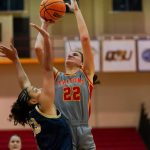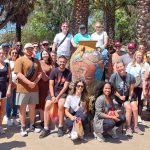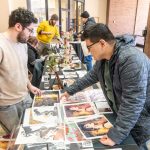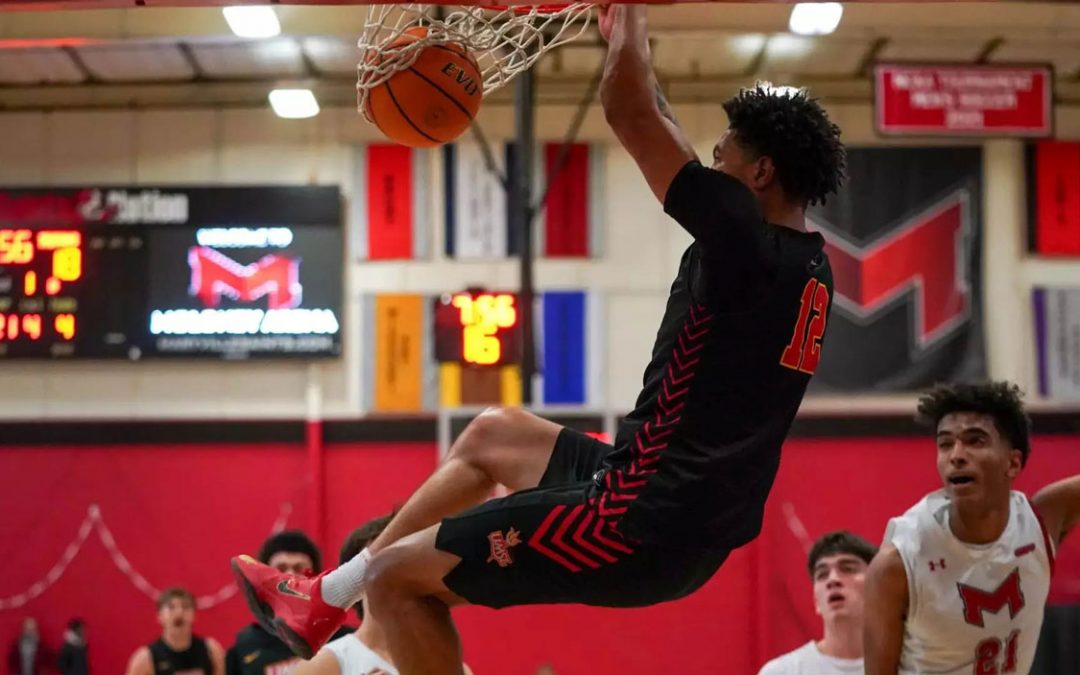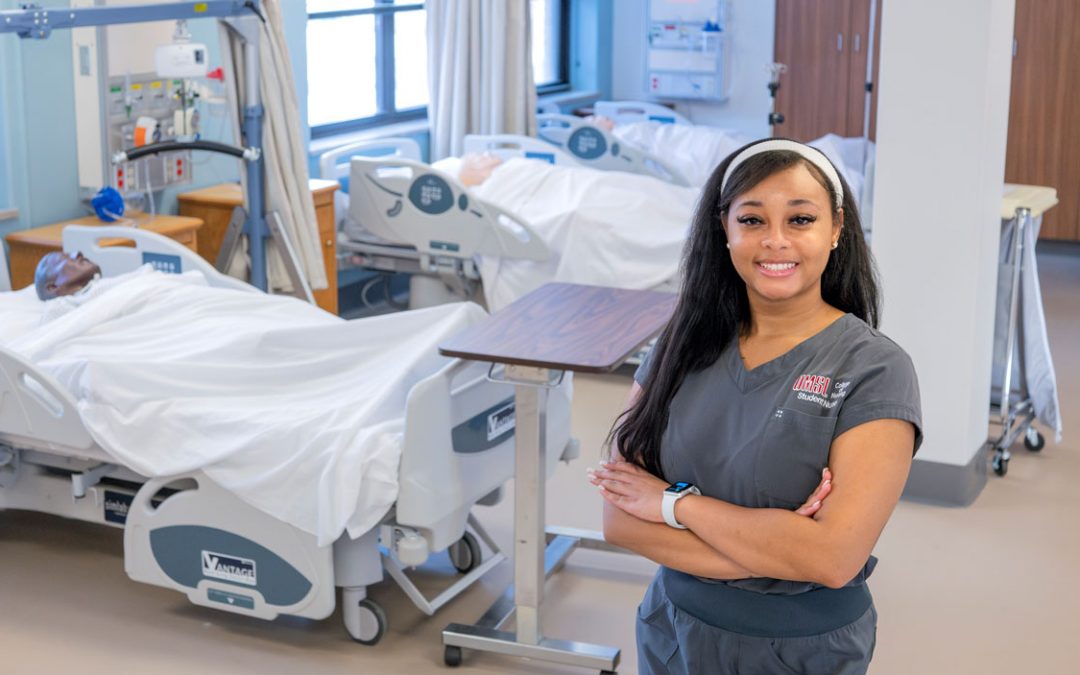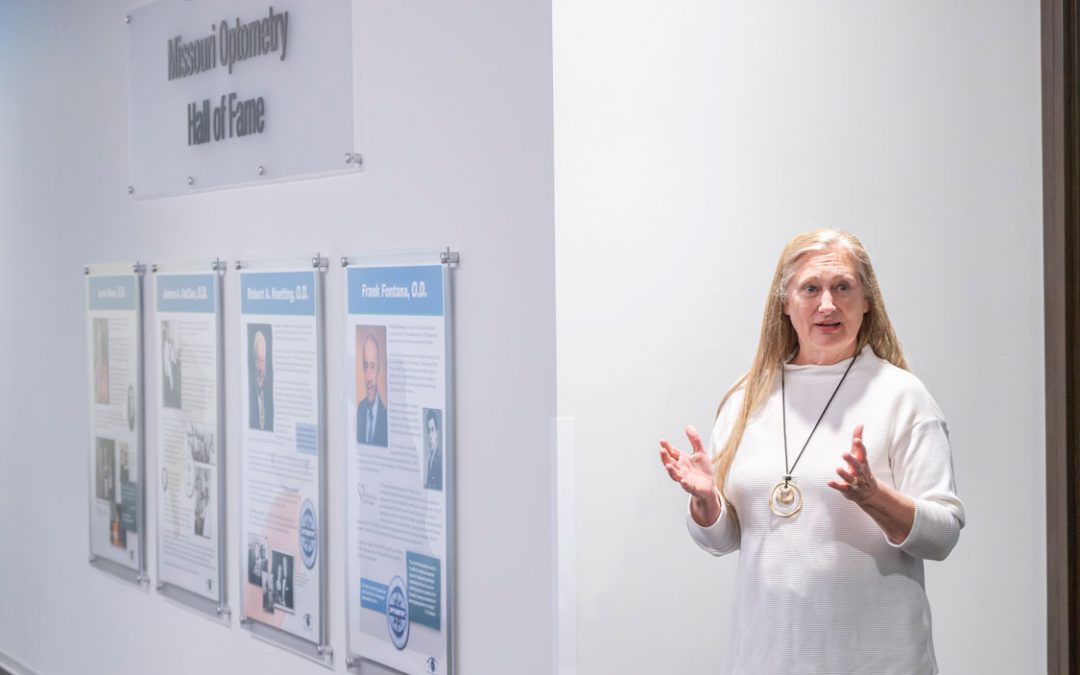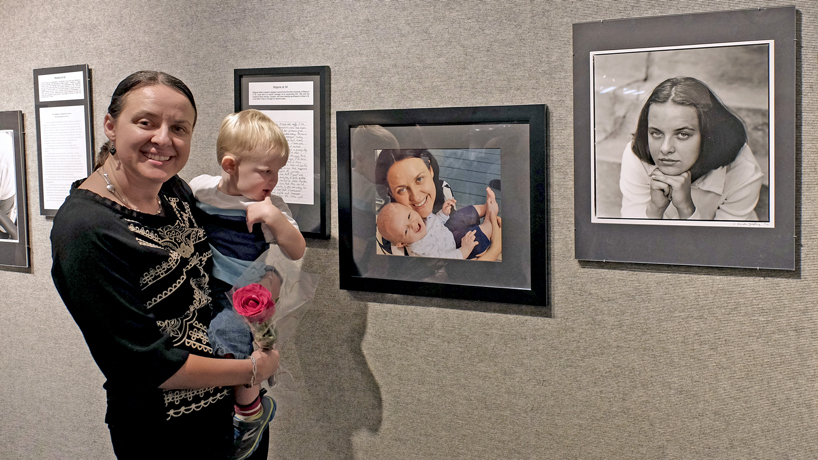
UMSL alumna Majana Reis and her son, Cayden, attended the opening of The Resilient Souls Project in the Morton J. May Foundation Gallery on the Maryville University campus. (Photo by August Jennewein)
The similarities are readily apparent in the photograph of the 14-year-old girl at right with her chin resting on her folded hands and the one next to it of the woman, 20 years her elder, holding up her infant son.
The subjects share round faces, deep-set eyes and the same dark brown hair, parted in the center and trimmed at the shoulders.
They have other similarities too, ones that can’t be known simply by sight. Among them, both were still getting settled in the St. Louis area after relocating barely a year – if that – before the images were captured.
But there were just as many differences in where the two found themselves in life.
Majana Burazovic, the 14-year-old, might have been optimistic, but she also was anxious, unsure how she was going to endure in what still felt like a strange world about two years after she arrived from Bosnia and Herzegovina, a refugee of civil war.
Majana Reis – her married name – has not only survived but thrived, earning both bachelor’s and master’s degrees in economics from the University of Missouri–St. Louis and spending the past 11 years working at Ernst & Young. She spent seven of those years working in the firm’s Chicago office.
By the time Reis and her husband, Justin, moved back to St. Louis and she returned to the company’s office in Clayton, she had risen the ranks to become a senior manager in the company’s International Tax Services group. She assists corporations with transfer pricing.
Their homecoming was born out of a desire to live closer to family after the birth of their son, Cayden, now more than a year-and-a-half old.
A photo and literary exhibit by photographer Cathy Lander-Goldberg has captured the changes in Reis and other women from around the St. Louis area in the past two decades. The Resilient Souls Project, which debuted Nov. 17, will continue its run through Dec. 16 at the Morton J. May Foundation Gallery on the campus of Maryville University.
“It really is a story of the human spirit,” Reis said of the exhibit. “These women have gone through a lot and have really amazing stories, and this is our community. To go through it and read some of these stories, it’s just really amazing. You admire people, and you admire how strong they are, and I think not everybody would be able to go through this.”
Lander-Goldberg first photographed all of her subjects in 1996 and collected them in an exhibit she displayed then at the Center of Creative Arts.
She had learned of Reis through a story Diana Aitchison wrote in the Kansas City Star. Aitchison featured the teenager in January 1995 while capturing the experience of Bosnian immigrants who had begun flooding into St. Louis after civil war erupted in Bosnia in 1992.
The bitter and gruesome fighting led Reis and her family to flee their home in Prijedor, and they moved often, sometimes taken in and supported by total strangers.
When she was 12 years old, she wrote a poem that was later translated and published in a book, “The Suitcase: Refugee Voices from Bosnia and Croatia,” under the title, “Why Me?”
It reads, in part: “Sometimes I ask myself: why am I the one who can only dream to have peace, freedom, happiness and whose home is destroyed even if I didn’t want it? Why am I the one to whom it is normal to see dead bodies on the street and the one who in the cellars listens to the sound of bombs.”
For a time she lived with her mother, sister, grandmother and aunt in a concentration camp.
“Definitely all of the events were very traumatizing,” Reis said. “Sometimes, I joke with my husband, I’m like, ‘I don’t know how …’ Sometimes I question my sanity.”
Reis uses the same word – traumatizing – to describe what it was like to come to the United States as a teenager, trading what had been an upper middle-class existence before the fighting began in Bosnia for a lower-class life as a refugee.
Her family wound up in St. Louis after being sponsored by a great uncle who’d already lived here. They moved into the Shaw Neighborhood, and her mother landed a job working the overnight shift in a factory. Reis started at the local public school where she was bumped up one grade level because of her summer birthday, starting as a seventh grader in the fall of 1994.
Initially, she was fearful of whether she’d be able to keep up, particularly as she was trying to master English. But it turned out the bigger challenge was fitting in with classmates who weren’t very welcoming and coming to grips with an environment where learning didn’t seem to be a priority.
Reis isn’t sure where she would be today if she had continued in that climate.
But Aitchison, with whom Reis stayed in contact and who wrote about her again in a follow-up story in 1996, worked on her behalf to get her an opportunity at a private school.
St. Elizabeth Academy offered her a scholarship, and as she would later at UMSL, she thrived.
“I feel like at that point, my life started to change because my education started to change,” Reis said.
It was near the same time that Lander-Goldberg photographed her for the first exhibit.
Reis would go on to serve on student council and as president of National Honors Society at St. Elizabeth. She played soccer, acted in a play and was an editor of the student newspaper.
She enrolled in Saint Louis University after finishing high school, intent on being pre-med and one day becoming a pediatrician. But it only took one semester for her to have a change of heart.
Reis initially switched majors to psychology but found that also wasn’t for her, so she pondered a change to business and took some economics courses.
“I really liked it,” she said. “I like stories. I’ve always liked stories, and economics is about telling stories. There’s an event, and we’re trying to explain it by looking at sort of the micro and macro factors that have affected and led us to be in this particular situation.
“To me, I thought that was really interesting because it’s about telling a story that’s sort of rational. There’s some facts behind it. There’s some unknowns behind it, and a lot of this is driven by incentives and human behavior.”
Reis was also learning to do cost-benefit analysis and figured out how costly her bachelor’s degree at the private university would wind up being. She wound up looking into other options and decided to transfer to UMSL after a meeting with Professor Anne Winkler, now the chair of the Department of Economics.
It proved to be an ideal learning environment.
“One, our econ department professors are really awesome,” she said. “Two, my class was really good. I love how Professor Winkler sometimes refers to us as cohorts. She goes, ‘Your cohorts …’ – which is very economics. But my class of cohorts was very good. We just were a very smart bunch of people, very enthusiastic about learning.”
Reis also took advantage of the BS/MA Dual Degree program, spending an extra three semesters to complete her master’s degree before graduating in 2005.
That decision paid off quickly when she accepted a position with Ernst & Young and, within a year, was eligible for a promotion to a management position despite not being a certified public accountant because she had an advanced degree.
Reis worked in the Chicago office between 2008 and 2015.
A few months after her return to St. Louis in September of last year, she heard from Lander-Goldberg, who explained her idea for an update exhibit.
Reis was quickly on board. Lander-Goldberg photographed her again – this time holding Cayden – earlier this year, and Reis wrote an essay to accompany the exhibit.
She attended the opening on Nov. 17 and might have been most excited to read the words she had written as a 14-year-old to accompany the original exhibit in 1996, especially with the perspective she has gained over 20 years.
“I just love her,” she said of the young woman who penned it. “Even though it’s me, I just love her because sometimes I think, ‘Was I really that enthusiastic?’ She was so bright-eyed and seeing the possibilities. I think at that time I was really seeing the possibilities and the opportunities that were available to really say, ‘This country really is great. I’m so glad we moved here. Things are starting to really look up, and it’s going to be really great, and I’m going to make the best out of it.’
“Considering how I remember that time, I don’t remember that optimism. I was so glad.”









